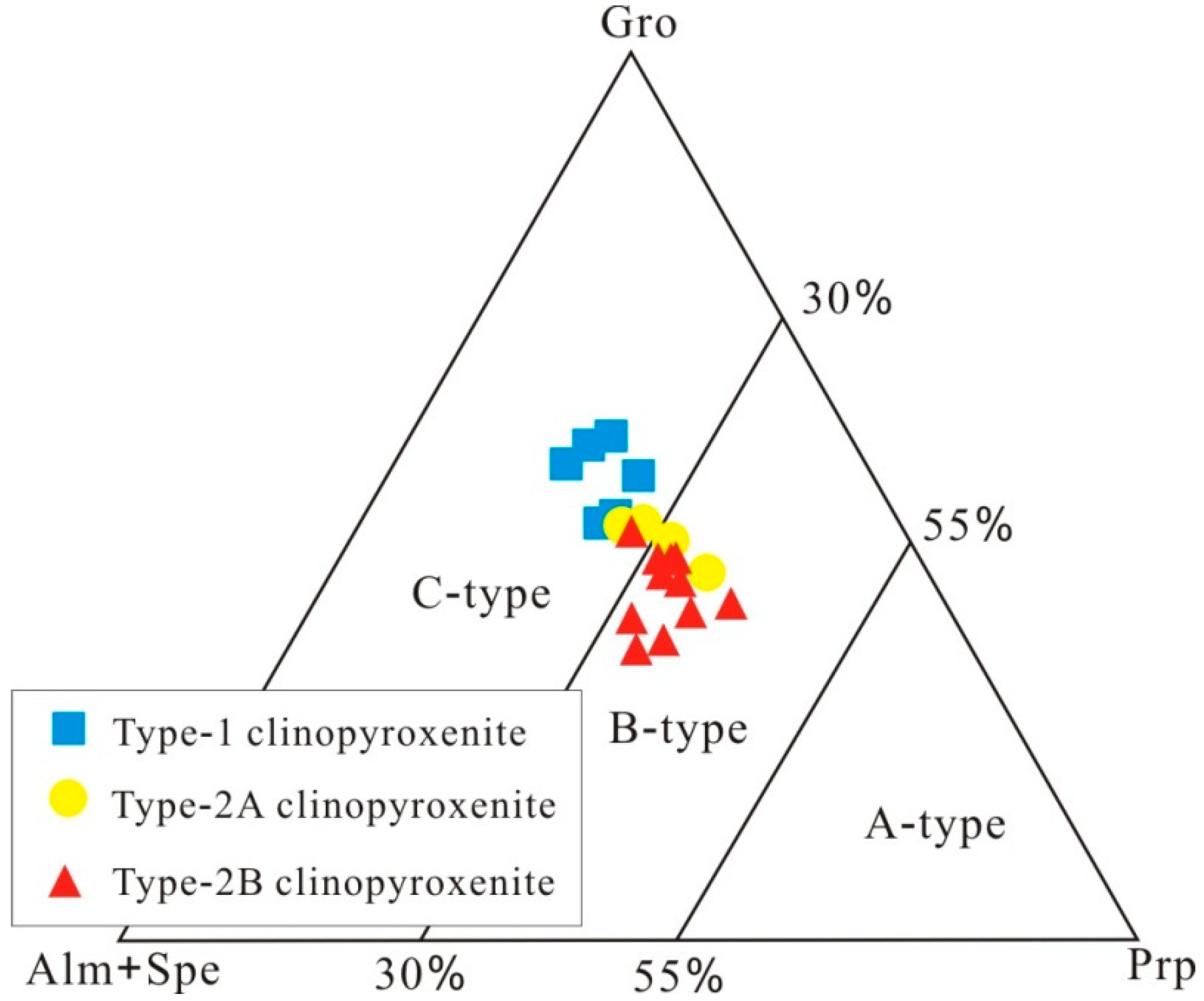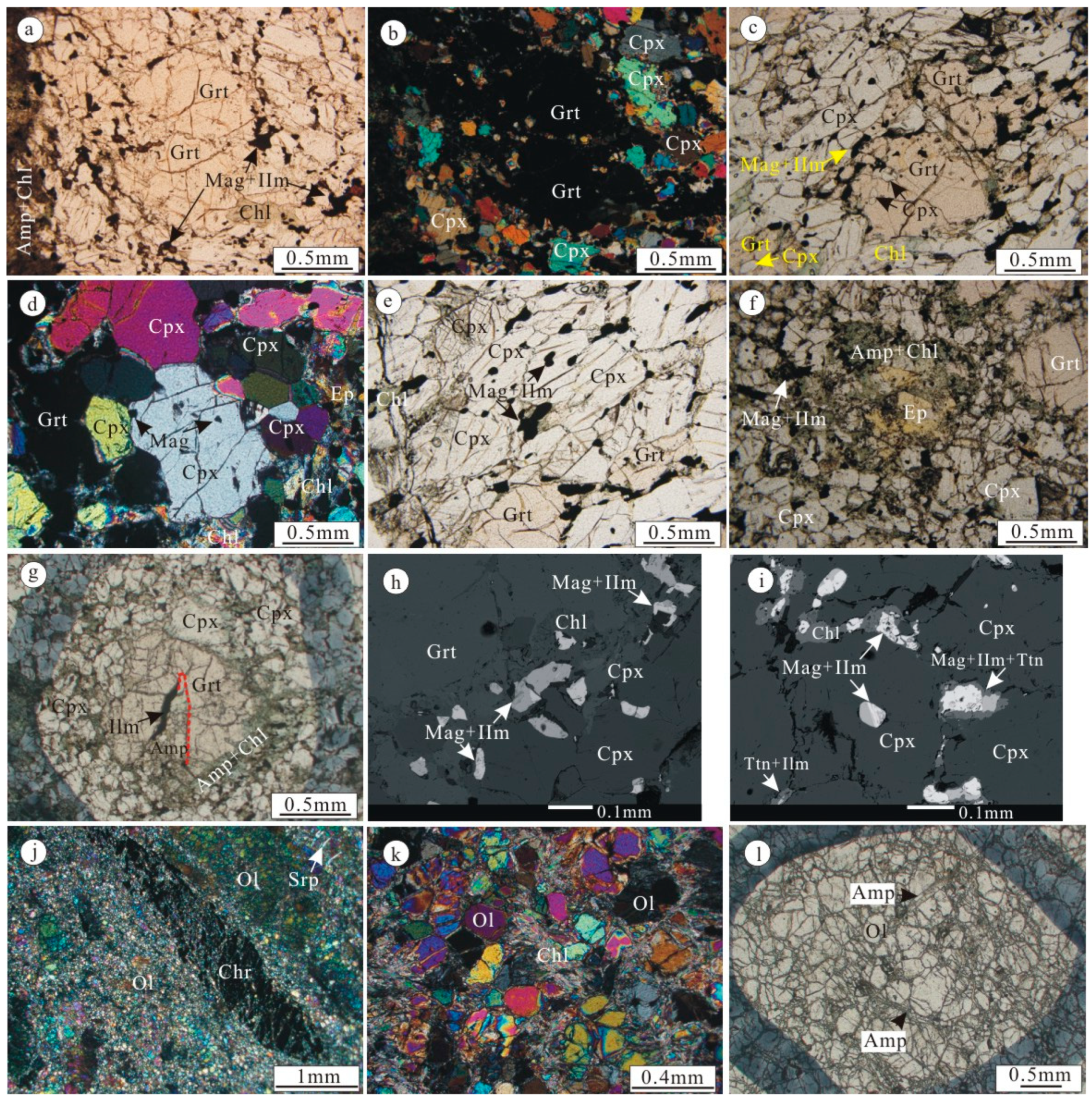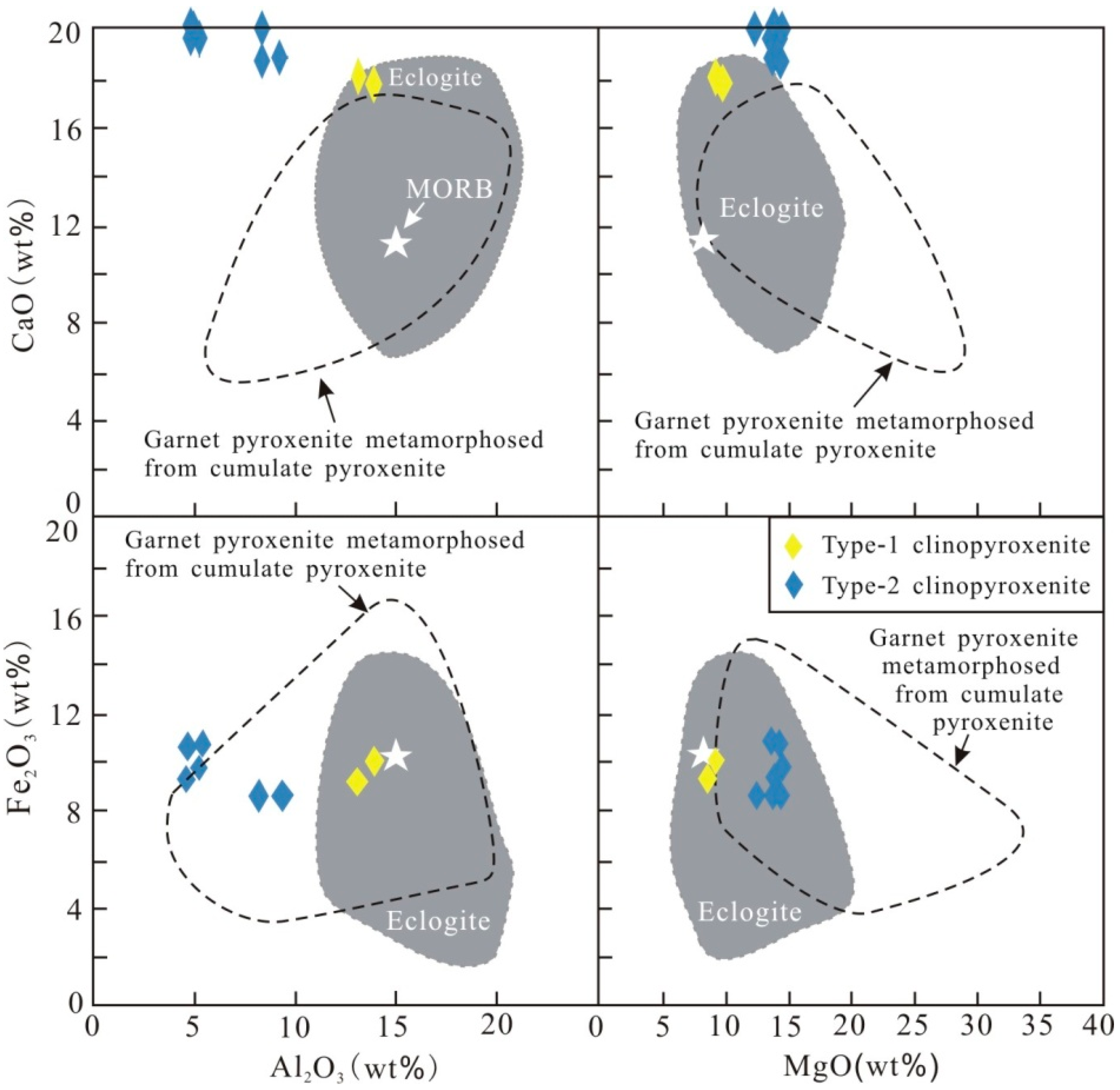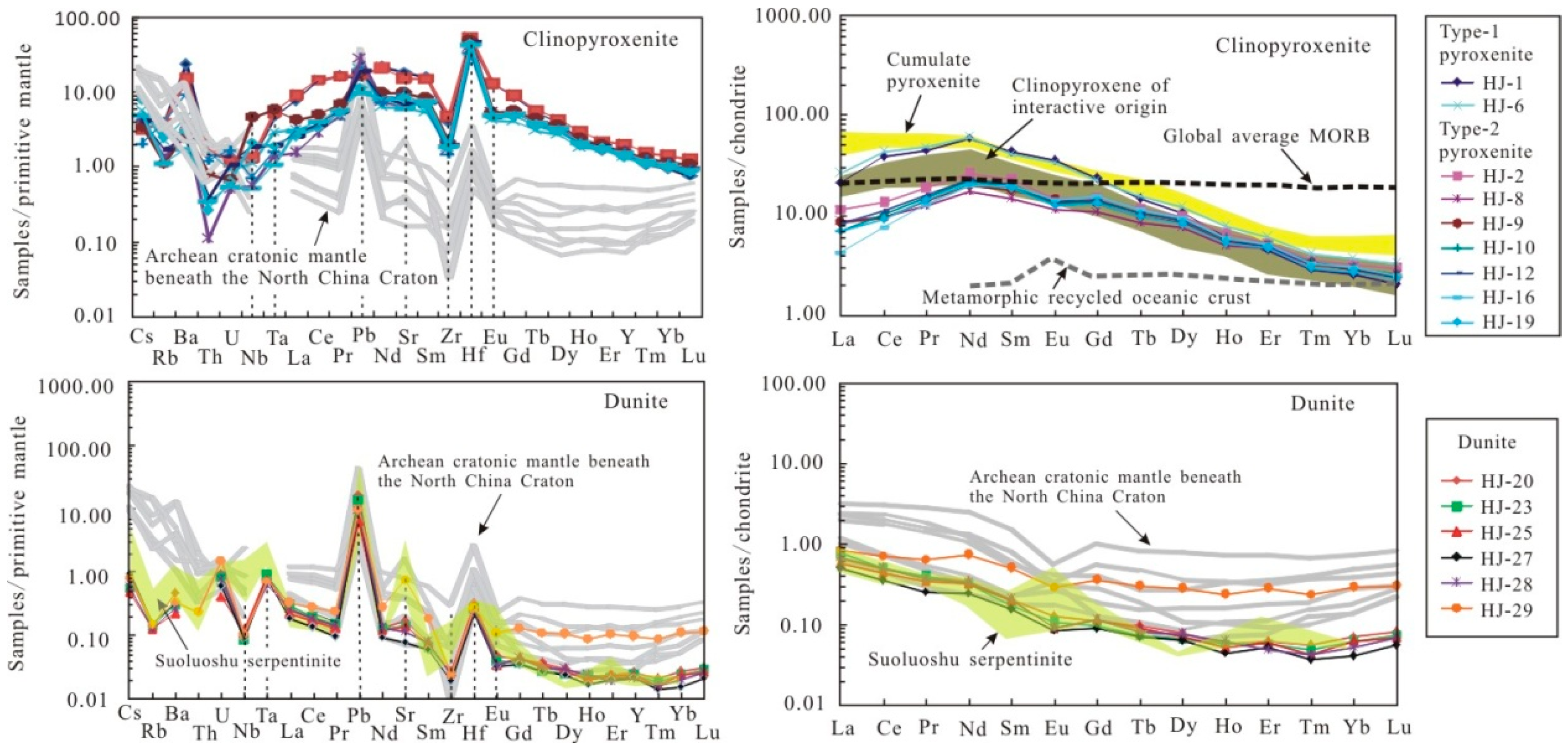Petrogenesis of Garnet Clinopyroxenite and Associated Dunite in Hujialin, Sulu Orogenic Belt, Eastern China
Abstract
:1. Introduction

2. Geological Setting
3. Materials and Methods
3.1. Sample Description
3.2. Analytical Methods
4. Results
4.1. Mineral Chemistry
4.1.1. Clinopyroxene and Garnet in Clinopyroxenite



4.1.2. Olivine and Chromite in Dunite

4.1.3. Other Minerals
4.2. Bulk-Rock Compositions
4.2.1. Major Elements
4.2.2. Minor Elements
5. Discussion
5.1. Origin of Hujialin Garnet Clinopyroxenite and Nature of Metasomatic Agent
5.2. Origin of Dunite
5.3. Tectonic Evolutions of Hujialin Garnet Clinopyroxenite and Dunite
6. Conclusions
Supplementary Materials
Author Contributions
Funding
Data Availability Statement
Acknowledgments
Conflicts of Interest
References
- Zhang, R.Y.; Liou, J.G.; Ernst, W.G. The Dabie-Sulu continental collision zone: A comprehensive review. Gondwana Res. 2009, 16, 1–26. [Google Scholar] [CrossRef]
- Xie, Z.P.; Hattori, K.; Wang, J. Origins of ultramafic rocks in the Sulu Ultrahigh-pressure Terrane, Eastern China. Lithos 2013, 178, 158–170. [Google Scholar] [CrossRef]
- Xie, Z.P.; Hattori, K.; Dong, Y.P.; Wang, J. In situ characterization of forearc serpentinized peridotite from the Sulu ultrahigh-pressure terrane: Behavior of fluid-mobile elements in continental subduction zone. Geosci. Front. 2021, 12, 101139. [Google Scholar] [CrossRef]
- Yang, J.S.; Xu, Z.Q.; Dobrzhinetskaya, L.F.; Green, H.W., II; Pei, X.Z.; Shi, R.D.; Wu, C.L.; Wooden, J.L.; Zhang, J.X.; Wan, Y.S.; et al. Discovery of metamorphic diamonds in central China: An indication of a >4000-km-long zone of deep subduction resulting from multiple continental collisions. Terra Nova 2003, 15, 370–379. [Google Scholar] [CrossRef]
- Wang, Z.L.; Zhang, S.K.; Li, X.P.; Wang, S.J.; Wang, D.; Kong, F.M.; Liu, J.G.; Li, Z.S.; Li, D.P.; Wang, J.; et al. Metamorphic evolution of garnet-bearing ultramafic rocks in the Hujialin area, Sulu ultrahigh-pressure orogenic belt, Eastern China. Minerals 2020, 10, 225. [Google Scholar] [CrossRef] [Green Version]
- Zhang, R.Y.; Liou, J.G.; Yang, J.S.; Yui, T.F. Petrochemical constraints for dual origin of garnet peridotites from the Dabie-Sulu UHP terrane, eastern-central China. J. Metamorph. Geol. 2000, 18, 149–166. [Google Scholar] [CrossRef]
- Xie, Z.P.; Wang, J.; Hattori, K.; Xue, C.D.; Zhong, J.W.; Qang, Z.L. The petrogenesis and tectonic implication of Hujialin ultramafic rocks in the Sulu ultrahigh-pressure metamorphic belt, eastern China. Acta Petrol. Sin. 2018, 34, 1539–1556, (In Chinese with English Abstract). [Google Scholar]
- Zhang, Y.L.; Xu, Y.G. Pyroxenites: High-pressure segregates or recycled oceanic crust? Geol. J. China Univ. 2012, 18, 74–87, (In Chinese with English Abstract). [Google Scholar]
- Li, T.F.; Yang, J.S. Geochemical characteristics of garnet clinopyroxenite at Hujialing, Rizhao, and their bearing on petrogenesis. Acta Petrol. Mineral. 2005, 24, 469–475, (In Chinese with English Abstract). [Google Scholar]
- Yang, J.J. Ca-rich garnet-clinopyroxene rocks at Hujialin in the Su-Lu terrane (eastern China): Deeply subducted arc cumulates? J. Petrol. 2006, 47, 965–990. [Google Scholar] [CrossRef] [Green Version]
- Xie, Z.P.; Wang, J.; Hattori, K. Cumulates of arc magmas incorporated into the Sulu UHP metamorphic belt, eastern China. Int. Geol. Rev. 2016, 58, 703–718. [Google Scholar] [CrossRef]
- Li, H.Y.; Chen, R.X.; Zheng, Y.F.; Hu, Z.C. Water in garnet pyroxenite from the Sulu orogen: Implications for crust-mantle interaction in continental subduction zone. Chem. Geol. 2018, 478, 18–38. [Google Scholar] [CrossRef]
- Zheng, Y.F.; Fu, B.; Gong, B.; Li, L. Stable isotope geochemistry of ultrahigh pressure metamorphic rocks from the Dabie-Sulu orogen in China: Implications for geodynamics and fluid regime. Earth Sci. Rev. 2003, 62, 105–161. [Google Scholar] [CrossRef]
- Chen, R.X.; Yin, Z.Z.; Xia, C.P. Crustal metasomatism of mantle wedge during collisional orogeny: Insights from orogenic peridotites in the Dabie-Sulu progenic belt. Bull. Mineral. Petrol. Geochem. 2019, 38, 459–484, (In Chinese with English Abstract). [Google Scholar]
- Zhang, R.Y.; Liou, J.G. Clinopyroxenite from the Sulu ultrahigh-pressure terrane, eastern China: Origin and evolution of garnet exsolution in clinopyroxene. Am. Mineral. 2003, 88, 1591–1600. [Google Scholar] [CrossRef]
- Zhang, R.Y.; Hirajima, T.; Banno, S.; Cong, B.; Liou, J.G. Petrology of ultrahigh-pressure rocks from the southern Su-Lu region, eastern China. J. Metamorph. Geol. 1995, 13, 659–675. [Google Scholar] [CrossRef]
- Zheng, Y.F.; Zhou, J.B.; Wu, Y.B.; Xie, Z. Low-grade metamorphic rocks in the Dabie-Sulu orogenic belt: A passive-margin accretionary wedge deformed during continent subduction. Int. Geol. Rev. 2005, 47, 851–871. [Google Scholar] [CrossRef]
- Zheng, Y.F.; Zhao, Z.F.; Chen, R.X. Ultrahigh-pressure metamorphic rocks in the Dabie–Sulu orogenic belt: Compositional inheritance and metamorphic modification. In HP–UHP Metamorphism and Tectonic Evolution of Orogenic Belts; Zhang, L.F., Zhang, Z., Schertl, H.P., Wei, C., Eds.; Geological Society; Special Publications: London, UK, 2019; Volume 474, pp. 89–132. [Google Scholar]
- Liu, F.L.; Liou, J.G. Zircon as the best mineral for P-T-time history of UHP metamorphism: A review on mineral inclusions and U-Pb SHRIMP ages of zircons from the Dabie-Sulu UHP rocks. J. Asian Earth Sci. 2011, 40, 1–39. [Google Scholar] [CrossRef]
- Ye, K.; Cong, B.L.; Ye, D.N. The possible subduction of continental material to depths greater than 200 km. Nature 2000, 407, 734–736. [Google Scholar] [CrossRef]
- Liu, F.L.; Xu, Z.Q.; Liou, J.G.; Katayama, I.; Masago, H.; Maruyama, S.; Yang, J.S. Ultrahigh-pressure mineral inclusions in zircons from gneissic core samples of the Chinese Continental Scientific Drilling Site in eastern China. Eur. J. Mineral. 2002, 14, 451–499. [Google Scholar]
- Liu, F.L.; Xu, Z.Q.; Yang, J.S.; Zhang, Z.M.; Xue, H.M.; Li, T.F. Geochemical characteristics and UHP metamorphism of granitic gneisses in the main drilling hole of the Chinese Continental Scientific Drilling Project and its adjacent area. Acta Petrol. Sin. 2004, 20, 9–26, (In Chinese with English Abstract). [Google Scholar]
- Yang, J.J.; Jahn, B.M. Deep subduction of mantle-derived garnet peridotites from the Su-Lu UHP metamorphic terrane in China. J. Metamorph. Geol. 2000, 18, 167–180. [Google Scholar] [CrossRef]
- Liu, F.L.; Xu, Z.Q.; Xue, H.M. Tracing the protolith, UHP metamorphism, and exhumation ages of orthogneiss from the SW Sulu terrane (eastern China): SHRIMP U-Pb dating of mineral inclusion-bearing zircons. Lithos 2004, 78, 411–429. [Google Scholar] [CrossRef]
- Zong, K.Q.; Liu, Y.S.; Gao, C.G.; Hu, Z.C.; Gao, S.; Gong, H.J. In situ U–Pb dating and trace element analysis of zircons in thin sections of eclogite: Refining constraints on the ultrahigh-pressure metamorphism of the Sulu terrane, China. Chem. Geol. 2010, 269, 237–251. [Google Scholar] [CrossRef]
- Chen, J.; Xu, Z. Pargasite and ilmenite exsolution texture in clinopyroxenes from Hujialing garnet-pyroxenite, Su-Lu UHP terrane, Central China: A geodynamic implication. Eur. J. Mineral. 2005, 17, 895–903. [Google Scholar] [CrossRef]
- Gao, T.S.; Chen, J.F.; Xie, Z.; Yang, S.H.; Yu, G. Zircon SHRIMP U-Pb age of garnet olivine pyroxenite at Hujialin in the Sulu terrane and its geological significance. Chin. Sci. Bull. 2004, 49, 2198–2204. [Google Scholar] [CrossRef]
- Zhao, R.X.; Liou, J.G.; Tsujimori, T.; Zhang, R.Y. Petrology and U-Pb SHRIMP geochronology of a garnet peridotite, Sulu UHP terrane, east-central China. Int. Geol. Rev. 2007, 49, 732–752. [Google Scholar] [CrossRef]
- Li, T.F.; Yang, J.S.; Zhang, R.Y. Geochemical characteristics and UHP metamorphic age of the Hujialing garnet clinopyroxenite from the Sulu terrane, China and the bearing on its genesis. Int. Geol. Rev. 2008, 50, 48–60. [Google Scholar] [CrossRef]
- Whitney, D.L.; Evans, B.W. Abbreviations for names of rock-forming minerals. Am. Mineral. 2010, 95, 185–187. [Google Scholar] [CrossRef]
- Li, M.; Han, Z.Z.; Bi, C.Y.; Zhang, H.; Li, J.R.; Cui, Z.Y. Mineral geochemistry of eclogite in the Sulu belt and its implication. Period. Ocean Univ. China (Nat. Sci. Ed.) 2015, 45, 63–70, (In Chinese with English Abstract). [Google Scholar]
- Feng, P.; Wang, L.; Brown, M.; Johnson, T.M.; Kylander-Clark, A.; Piccoli, P.M. Partial melting of ultrahigh-pressure eclogite by omphacite-breakdown facilitates exhumation of deeply-subducted crust. Earth Planet. Sci. Lett. 2021, 554, 116664. [Google Scholar] [CrossRef]
- Coleman, R.G.; Lee, D.E.; Beatty, L.B.; Brannock, W.W. Eclogites and eclogites: Their similarities and differences. Geol. Soc. Am. Bull. 1965, 76, 483–508. [Google Scholar] [CrossRef]
- Morimoto, N. Nomenclature of pyroxenes. Mineral. Mag. 1988, 52, 535–550. [Google Scholar] [CrossRef]
- Liu, Y.D.; Ying, J.F. Origin of clinopyroxene megacrysts in volcanic rocks from the North China Craton: A comparison study with megacrysts worldwide. Int. Geol. Rev. 2019, 61, 1–17. [Google Scholar] [CrossRef]
- Xu, W.L.; Zhou, Q.J.; Pei, F.P.; Yang, D.B.; Gao, S.; Li, Q.L.; Yang, Y.H. Destruction of the North China Craton: Delamination or thermal/chemical erosion? Mineral chemistry and oxygen isotope insights from websterite xenoliths. Gondwana Res. 2013, 23, 119–129. [Google Scholar] [CrossRef]
- Zheng, J.P.; O’Reilly, S.Y.; Griffin, W.L.; Lu, F.X.; Zhang, M.; Pearson, N.J. Relics of refractory mantle beneath the eastern North China Block: Significance for lithosphere evolution. Lithos 2001, 57, 43–66. [Google Scholar] [CrossRef]
- Zheng, J.P.; Griffin, W.L.; O’Reilly, S.Y.; Yang, J.S.; Li, T.F.; Zhang, M.; Zhang, R.Y.; Liou, J.G. Mineral chemistry of peridotites from Paleozoic, Mesozoic and Cenozoic Lithosphere: Constraints on mantle evolution beneath Eastern China. J. Petrol. 2006, 47, 2233–2256. [Google Scholar] [CrossRef]
- Ying, J.F.; Zhang, H.F.; Kita, N.; Morishita, Y.; Shimoda, G. Nature and evolution of Late Cretaceous lithospheric mantle beneath the eastern North China Craton: Constraints from petrology and geochemistry of peridotitic xenoliths from Junan, Shandong Province, China. Earth Planet. Sci. Lett. 2006, 244, 622–638. [Google Scholar] [CrossRef]
- Xu, W.L.; Yang, D.B.; Gao, S.; Pei, F.P.; Yu, Y. Geochemistry of peridotite xenoliths in Early Cretaceous high-Mg# diorites from the Central Orogenic Block of the North China Craton: The nature of Mesozoic lithospheric mantle and constraints on lithospheric thinning. Chem. Geol. 2010, 270, 257–273. [Google Scholar]
- Saumur, B.M.; Hattori, K. Zoned Cr-spinel and ferritchromite alteration in forearc mantle serpentinites of the Rio San Juan Complex, Dominican Republic. Mineral. Mag. 2013, 77, 117–136. [Google Scholar] [CrossRef]
- Hattori, K.H.; Guillot, S.; Saumur, B.M.; Tubrett, M.N.; Vidal, O.; Morfin, S. Corundum-bearing garnet peridotite from northern Dominican Republic: A metamorphic product of an arc cumulate in the Caribbean subduction zone. Lithos 2010, 114, 437–450. [Google Scholar] [CrossRef]
- Ozawa, K. Melting and melt segregation in the mantle wedge above a subduction zone: Evidence from the chromite-bearing peridotites of the Miyamori Ophiolite Complex, northeastern Japan. J. Petrol. 1994, 35, 647–678. [Google Scholar] [CrossRef]
- Nakamura, M. Residence time and crystallization history of nickeliferous olivine phenocrysts from northern Yatsugatake volcanoes, central Japan: Application of a growth and diffusion model in the system Mg-Fe-Ni. J. Volcanol. Geoth. Res. 1995, 66, 81–100. [Google Scholar] [CrossRef]
- Ishii, T.; Robinson, P.T.; Maekawa, H.; Fiske, R. Petrological studies of peridotites from diapiric serpentinite seamounts in the Izu-Ogasawara-Mariana forearc Leg 125. In Proceedings of the Ocean Drilling Program Scientific Results; Fryer, P., Pearce, J.A., Stokking, L.B., Eds.; Ocean Drilling Program: College Station, TX, USA, 1992; Volume 125, pp. 445–485. [Google Scholar]
- Parkinson, I.J.; Pearce, J.A. Peridotites from the IzuBonin-Mariana forearc (ODP Leg 125): Evidence for mantle melting and melt-mantle interaction in a supra-subduction zone setting. J. Petrol. 1998, 39, 1577–1618. [Google Scholar] [CrossRef]
- Hattori, K.H.; Guillot, S. Geochemical character of serpentinites associated with high- to ultrahigh pressure metamorphic rocks in the Alps, Cuba, and the Himalayas: Recycling of elements in subduction zones. Geochem. Geophys. Geosyst. 2007, 8, Q09010. [Google Scholar] [CrossRef] [Green Version]
- Arai, S.; Okamura, H.; Kadoshima, K.; Tanaka, C.; Suzuki, K.; Ishimaru, S. Chemical characteristics of chromian spinel in plutonic rocks: Implications for deep magma processes and discrimination of tectonic setting. Isl. Arc 2011, 20, 125–137. [Google Scholar] [CrossRef] [Green Version]
- Enami, M.; Liou, J.G.; Mattinson, C.G. Epidote minerals in high P/T metamorphic terranes: Subduction zone and high- to ultrahigh-pressure metamorphism. Rev. Mineral. Geochem. 2004, 56, 347–398. [Google Scholar] [CrossRef]
- Hawthorne, F.C.; Oberti, R.; Harlow, G.E.; Maresch, W.V.; Martin, R.F.; Schumacher, J.C.; Welch, M.D. Nomenclature of the amphibole super group. Am. Mineral. 2012, 97, 2031–2048. [Google Scholar] [CrossRef]
- Gonzaga, R.G.; Lowry, D.; Jacob, D.E.; LeRoex, A.; Schulze, D.; Menzies, M.A. Eclogites and garnet pyroxenites: Similarities and differences. J. Volcanol. Geoth. Res. 2010, 190, 235–247. [Google Scholar] [CrossRef]
- White, W.M.; Klein, E.M. 4.13-Composition of theoceanic crust. In Treatise on Geochemistry, 2nd ed.; Holland, H.D., Turekian, K., Eds.; Elsevier: Oxford, UK, 2014; Volume 4, pp. 457–496. [Google Scholar]
- Zhang, H.F.; Ying, J.F.; Shimoda, G.; Kita, N.T.; Morishita, Y.; Shao, J.A.; Tang, Y.J. Importance of melt circulation and crust-mantle interaction in the lithospheric evolution beneath the North China Craton: Evidence from Mesozoic basalt-borne clinopyroxene xenocrysts and pyroxenite xenoliths. Lithos 2007, 96, 67–89. [Google Scholar] [CrossRef]
- Liu, Y.S.; Gao, S.; Lee, C.T.A.; Hu, S.H.; Liu, X.M.; Yuan, H.L. Melt-peridotite interactions: Links between garnet pyroxenite and high-Mg# signature of continental crust. Earth Planet. Sci. Lett. 2005, 234, 39–57. [Google Scholar]
- Garrido, C.; Bodinier, J.L. Diversity of mafic rocks in the Ronda peridotite: Evidence for pervasive melt/rock reaction during heating of subcontinental lithosphere by upwelling asthenosphere. J. Petrol. 1999, 40, 729–754. [Google Scholar] [CrossRef]
- McDonough, W.F.; Sun, S.S. The composition of the Earth. Chem. Geol. 1995, 120, 223–253. [Google Scholar] [CrossRef]
- Yu, S.Y.; Xu, Y.G.; Ma, J.L.; Zheng, Y.F.; Kuang, Y.S.; Hong, L.B.; Ge, W.C.; Tong, L.X. Remnants of oceanic lower crust in the subcontinental lithospheric mantle: Trace element and Sr-Nd-O isotope evidence from aluminous garnet pyroxenite xenoliths from Jiaohe, Northeast China. Earth Planet. Sci. Lett. 2010, 297, 413–422. [Google Scholar] [CrossRef]
- Kelemen, P.B.; Shimizu, N.; Salters, V.J.M. Extraction of mid-ocean-ridge basalt from the upwelling mantle by focused of melt in dunite channels. Nature 1995, 375, 747–753. [Google Scholar] [CrossRef]
- Kelemen, P.B. Reaction between ultramafic rock and fractionating basaltic magma I. Phase relations, the origin of calc-alkaline magma series, and the formation of discordant dunite. J. Petrol. 1990, 31, 51–98. [Google Scholar] [CrossRef]
- Arai, S. Characterization of spinel peridotites by olivine-spinel compositional relationships: Review and interpretation. Chem. Geol. 1994, 113, 191–204. [Google Scholar] [CrossRef]
- Wang, J.; Hattori, K.; Xu, W.L.; Yang, Y.Q.; Xie, Z.P.; Liu, J.L.; Song, Y. Origin of ultramafic xenoliths in high-Mg diorites from east-central China based on their oxidation state and abundance of platinum group elements. Int. Geol. Rev. 2012, 54, 1203–1218. [Google Scholar] [CrossRef]
- Su, B.X.; Zhou, M.F.; Robinson, P.T. Extremely large fractionation of Li isotopes in a chromitite-bearing mantle sequence. Sci. Rep. 2016, 6, 22370. [Google Scholar] [CrossRef]
- Xiong, F.H.; Yang, J.S.; Xu, X.Z.; Kapsiotis, A.; Hao, X.L.; Liu, Z. Compositional and isotopic heterogeneities in the Neo-Tethyan upper mantle recorded by coexisting Al-rich and Cr-rich chromitites in the Purang peridotite massif, SW Tibet China. J. Asian Earth Sci. 2018, 159, 109–129. [Google Scholar] [CrossRef]
- Wang, J.; Hattori, K.; Stern, C.R. Metasomatic origin of garnet orthopyroxenites in the subcontinental lithospheric mantle underlying Pali Aike volcanic field, Southern South America. Mineral. Petrol. 2008, 94, 243–258. [Google Scholar] [CrossRef]
- Hiramatsu, N.; Hirajima, T. Petrology of the Hujialin garnet clinopyroxenite in the Su-Lu ultrahigh pressure province, eastern China. Isl. Arc 1995, 4, 310–323. [Google Scholar] [CrossRef]
- Wunder, B.; Wirth, R.; Gottschalk, M. Antigorite: Pressure and temperature dependence of polysomatism and water content. Eur. J. Mineral. 2001, 13, 485–495. [Google Scholar] [CrossRef] [Green Version]
- Arai, S. Possible recycled origin for ultrahigh-pressurechromitites in ophiolites. J. Mineral. Petrol. Sci. 2010, 105, 280–285. [Google Scholar] [CrossRef] [Green Version]
- Groves, D.I.; Santosh, M. The giant Jiaodong gold province: The key to a unified model for orogenic gold deposits? Geosci. Front. 2016, 7, 409–417. [Google Scholar] [CrossRef] [Green Version]






Publisher’s Note: MDPI stays neutral with regard to jurisdictional claims in published maps and institutional affiliations. |
© 2022 by the authors. Licensee MDPI, Basel, Switzerland. This article is an open access article distributed under the terms and conditions of the Creative Commons Attribution (CC BY) license (https://creativecommons.org/licenses/by/4.0/).
Share and Cite
Liu, J.; Wang, J.; Hattori, K.; Wang, Z. Petrogenesis of Garnet Clinopyroxenite and Associated Dunite in Hujialin, Sulu Orogenic Belt, Eastern China. Minerals 2022, 12, 162. https://doi.org/10.3390/min12020162
Liu J, Wang J, Hattori K, Wang Z. Petrogenesis of Garnet Clinopyroxenite and Associated Dunite in Hujialin, Sulu Orogenic Belt, Eastern China. Minerals. 2022; 12(2):162. https://doi.org/10.3390/min12020162
Chicago/Turabian StyleLiu, Jianguo, Jian Wang, Keiko Hattori, and Zeli Wang. 2022. "Petrogenesis of Garnet Clinopyroxenite and Associated Dunite in Hujialin, Sulu Orogenic Belt, Eastern China" Minerals 12, no. 2: 162. https://doi.org/10.3390/min12020162






